Please Take Note: This is a review of the final game, but it might change slightly based on the success of the Kickstarter campaign. The game is being reviewed on the components and the rules provided with the understanding that “what you see is not what you might get” when the game is published. If you like what you read and want to learn more, we encourage you to visit the game publisher’s website or visit the Kickstarter campaign. Now that we have all that disclaimer junk out of the way, on with the review.
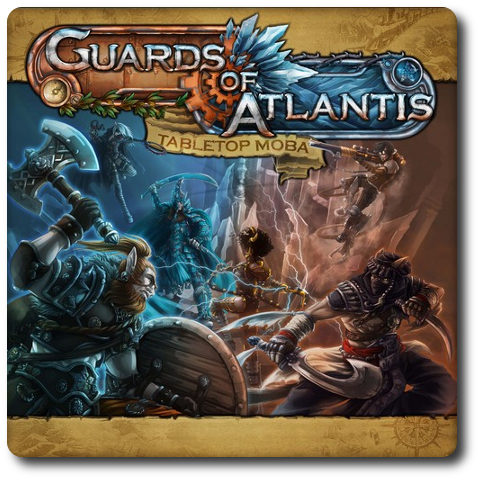
The Basics:
- For ages 8 and up (publisher suggests 12+)
- For 2 to 6 players
- Approximately 60 minutes to complete
Geek Skills:
- Active Listening & Communication
- Counting & Math
- Logical & Critical Decision Making
- Reading
- Strategy & Tactics
- Risk vs. Reward
- Visuospatial Skills
- Cooperative & Team Play
- Hand/Resource Management
- Area Control
Learning Curve:
- Child – Easy
- Adult – Easy
Theme & Narrative:
- Capture the throne
Endorsements:
- Gamer Geek approved!
- Parent Geek mixed!
- Child Geek approved!
Overview
Those who follow the ways of magic look at technology as a blight that ruins the natural order of things. Those who favor technology see those who use magic as unnatural and cursed. Both factions fear and hate each other. Their bitter rivalry will now end, once and for all.
Guards of Atlantis, designed by Artyom Nichipurov and to be published by Wolff Designa, will reportedly be comprised of 6 Hero miniatures (32mm scale), 2 “Fat” Minion miniatures, 2 “Ranged” Minion miniatures, 8 “Melee” Minion miniatures, 108 Hero cards, and 73 Coin tokens. As this is a review of a prepublished game, I cannot comment on the component quality or miniature details.
Marching to War
Note: Before playing, separate the players into 2 equal numbered teams.
To set up the game, first place the game board in the middle of the playing area.
Second, have each player select a Hero from their faction, Titans (magic users) or Atlanteans (technology users). After selecting a Hero, each player should find the matching Hero cards.
Note: Each Hero is unique and has certain abilities, but is not a defined class. Meaning, a player is not “locked” into playing a certain class type when they select a Hero. Each Hero can be customized during the game to fit the player’s style of play and needs of the game.
Third, each player should go through their deck of Hero cards and separate them by Tier level (there are 3 tier levels in total). A player’s starting cards consists of all Tier 1 Hero cards. Tier 2 and Tier 3 will be used later in the game. Set the higher level Tier cards to one side for now.
Fourth, players place their Hero figure on any available respawn point that belongs to their faction. These are found on the faction’s “Throne”. While the location is unimportant, each player should remember what respawn point they selected, as this is where they will move their Hero figure if they should ever fall during combat.
Fifth, all players now place their faction’s Minion figures in the center-most section of the game board. Icons are provided that are used to match the face of the Minion figures. In total, each team will have 1 “heavy”, 1 “ranged”, and 4 “melee” Minion figures.
Sixth, place the Coin tokens to one side of the game board in a pool. While it would be best if this pool of Coins was easily reachable by all the players, you can also assign 1 player the responsibility of providing Coins to make the game move faster.
Magic Versus Technology
Guards of Atlantis is played in rounds and turns with no set number of rounds per game. A round of game play is summarized here.
Phase 1: Round Initiation
For the player’s first round of the game, this phase is skipped. All subsequent rounds must complete the first phrase before moving to the second phase.
In no particular player order, the following is completed to prep the playing area for the round of combat to come.
- All players return their played and discarded cards back to their hand.
- All defeated Heroes from the previous round are returned to their specific respawn point.
- Each player earns 1 Coin.
Phase 2: Into the Fray
The second phase is where the action and excitement of the game can be found. The following steps are taken in numerical order. This phase is repeated 4 times during each round of game play.
Step 1: Play One Card
The cards in the game always return to the player after each round of game play, but that doesn’t mean that the previously played card is still a valid choice. The battlefield is constantly shifting and a player might suddenly find their Hero figure on the front lines or way in the back. Further more, each player has a unique hand of cards that are tailored to their Hero, meaning that each player and their selected Hero bring something unique to each round of game play.
Reviewing the cards in their hand, each player selects 1 and places it in front of them, face-down. Each card represents an action the player’s Hero will take. A card’s anatomy is summarized here.
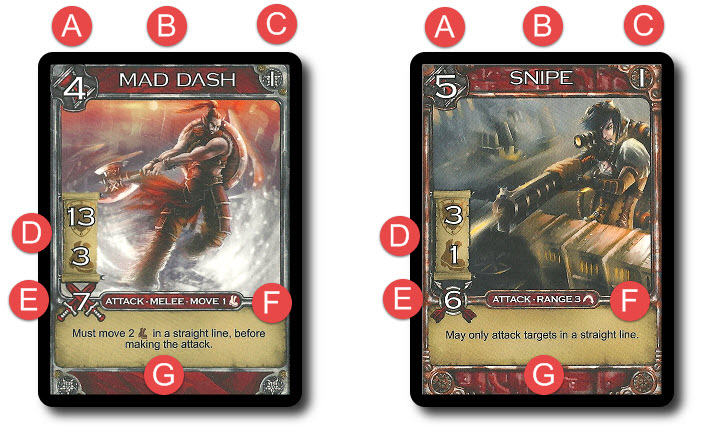
A) Initiative Value: Determines the order in which the cards are resolved.
B) Card Name: Used for thematic reasons.
C) Tier Level: The higher the Tier, the stronger the ability provided by the card.
D) Secondary Action: Every card provides a primary action and secondary actions (in this case, movement and defense).
E) Primary Action: The primary action is based on the Hero the player is controlling. Melee primary actions are noted with crossed swords, while ranged primary actions use crossed arrows.
F) Card Type and Keywords: The card type is noted here and any specific keywords that might be used by other cards.
G) Card Text: Describes how the card is used and its effects.
Step 2: Reveal Cards
Only after each player has placed a selected card face-down are they all revealed. The Initiative values are reviewed and the turn order sequence is determined. If 2 or more players have the same Initiative value from different factions, Atlanteans resolve their card and actions first. If 2 or more players have the same Initiative value that belong to the same faction, the team members can decide the order in which the Heroes take their actions.
Step 3: Resolve Actions
In turn order sequence, each player announces their Hero’s action and resolves it. Selected cards will include multiple actions, but only 1 can be used per round (cannot use two secondaries or 1 primary and 1 secondary actions). Possible actions include:
- Regular Movement: The Hero figure can move a number of spaces equal to the movement value. Hero figures cannot move through impassable terrain (mountains) or through spaces occupied by other figures. A player is never required to move their Hero figure the full length of their movement or move their Hero figure at all.
- Fast-Travel Movement: The Hero figure can move to any unequipped space that is in an adjacent area or is within the same area as the one the Hero figure currently occupies, but only if the areas do not contain any enemy figures. When fast-traveling, the movement space value is ignored.
- Skill: Skills are described on the card text and will provide a ranged effect for single targets or a radius effect for multiple targets. Some Skill effects continue after being resolved, while most are simply resolved and done.
- Attack: Heroes can attack any other Hero or Minion from another faction. Minions are defeated and removed from the board instantly, having no possible way of defending against a Hero’s brutal attack. Heroes versus Heroes takes longer. The presence of friendly figures might modify an attack.
Minions will never attack Hero figures, but they do give bonuses and penalties to Heroes if they are adjacent to them.
- “Melee” Minions: +1 Defense friendly Hero, -1 Defense to enemy Hero
- “Heavy” Minions (a.k.a. “Fat”): +1 Defense friendly Hero, -1 Defense to enemy Hero, Immune to attacks unless the last Minion remaining for the faction
- “Ranged” Minions: -1 Defense penalty to all enemies in the same area
There are two unique cards in a player’s hand that can be played during the round.
- Hold: The “Hold” Hero card is revealed at the same time as the other player’s. This allows the player to temporarily cause their Hero to hold their position.

- Reactions: Reaction cards are played from the player’s hand in response to attacks. Reaction cards provide a defense value (noted with a shield icon). If the defense value is equal to or greater than the attack value, the defender successfully avoids the attack. If not, the Hero is defeated and will be returned to the respawn point during the next round. Many cards in a player’s hand will provide defense as a secondary action.
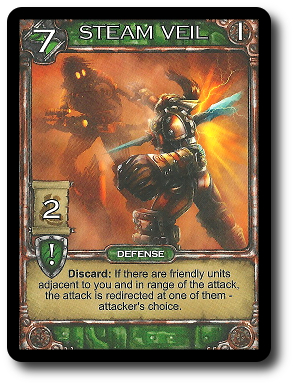
Once cards are resolved, either on a player’s turn or during as a reaction, they are temporarily discarded. Players will not be able to use their played cards again until the next round. This includes any cards that are played as reactions and defense.
Phase 3: Minions Advance and Leveling Up
After 4 turns of resolving cards, any Minion figures (also referred to as “Creeps”) still left on the game board now take an action. Combat between Minions is determined by counting the total number of Minions for one faction and the total number of Minions for the other that are still in play. Whichever team has the fewest Minions selects 1 Minion figure of their choice and removes it from the game board.
A player’s Hero levels up during game play by collecting Coins and then spending them. Coins are earned by taking out an enemy faction’s Minions and Heroes. The bigger the threat, the more Coins the take-down is worth. Coins can also be earned by using certain Skills. By default, every player earns 1 Coin after the round.
Advancing a level costs the player 1 more coin that the level they are advancing to. For example, to advance from Level 1 to Level 2 would cost the player 3 Coins. Advancing from Level 6 to Level 7 would cost the player 8 Coins.
After purchasing a level, the player upgrades their cards by adding higher Tier levels. When adding a card from a higher Tier, it must replace a card a lower level Tier card of the same color. Before a player can purchase the next Tier level of cards, they must fully replace their existing deck of cards with the currently highest possible tier level. For example, before a player can collect a Tier 3 card, they must replace all their Tier 1 cards with Tier 2 cards.
The player will also have an opportunity to give their Hero a Passive ability. These provide ongoing bonuses at all times during the game.
Tier 4 is only provided at level 8 and gives the player access to their Ultimate ability. Ultimate abilities are resolved in the same way as actions, but are much more powerful.
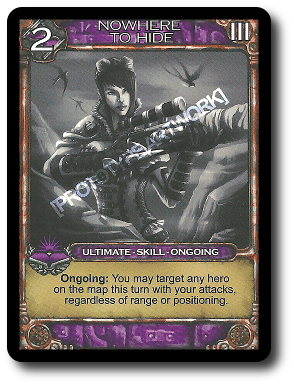
This completes the round. A new round now begins.
Toppling the Throne
The game continues as described above until 1 faction loses all their Minions in the current area in which they were located. The first area is the center. The next areas will be closer to 1 of the 2 faction’s thrones.
At anytime during the game all the Minions from a faction are removed from the game board (from Hero attacks or Minion combat), the owners of those Minions place them on the icons in the next area closest to their faction’s throne. Enemy faction Minions are moved to their icon space in the new area, as well. This relocation of falling back and advancing of Minions is referred to as “pushing the lane”. Thematically, as well as visually, it represents one faction’s loose of territory and another faction’s foothold on enemy territory.
When a faction is pushed all the way back to their Throne area, they have lost the struggle and the game.
To learn more about Guards of Atlantis, visit the game publisher’s website or visit the Kickstarter campaign.
Final Word
The Child Geeks were first drawn to the game due to its visual appeal. Guards of Atlantis is an interesting game to look at, with its bright colors and exotic looking characters. The game is also easy to learn and none of our Child Geeks had any problems figuring out what the cards did. What did cause them problems was managing their Hero cards. Cards played during the round do not return to the player until the end of the round, which is 4 turns later. According to one Child Geek, “You have to figure out what cards you want to use and what cards you think you’ll need if you want to defend yourself. Your best defense is to just stay out-of-the-way.” The Child Geeks also quickly learned that the Minions were easy targets, but the real threat was the enemy Heroes. As one Child Geek put it, “You can smash your enemy’s minions really easily, but if you get in a fight with another Hero, you best bring all your bandages.” When the games were over, the Child Geeks all voted to approve Guards of Atlantis.
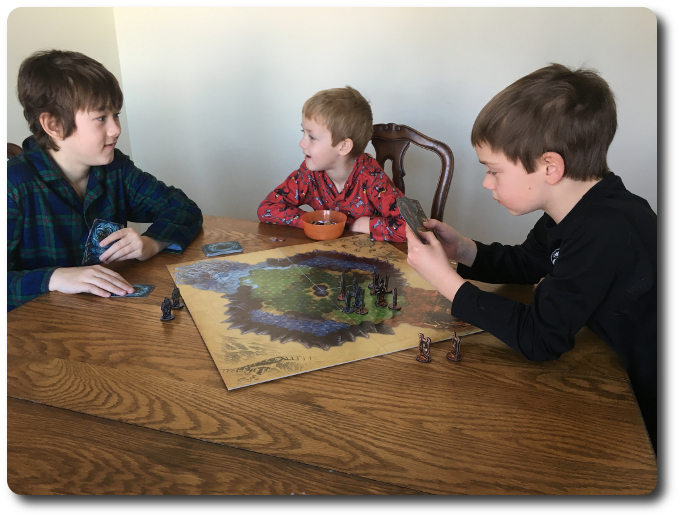
Even if Child Geeks couldn’t play, they still enjoyed watching and talking about what was going on in the game
The Parent Geeks had heard that Guards of Atlantis was similar to a massive online battle game. Very few of the Parent Geeks had any idea what that could possibly mean. Having video game knowledge is not necessary to play Guards of Atlantis, however, and all the Parent Geeks (regardless of their past video game playing experience) quickly learned how to play the game. According to one Parent Geek, “The only thing I don’t like about this game is that I cannot play against my 2 kids. I understand that the teams have to be even, but it means I can’t enjoy the game with the family.” Technically, you can enjoy he game with the family, but only an even number of family members can play at a time. Another Parent Geek said, “I don’t much care for battle games or even miniature games, but I found this one to be fun. I’m going to guess it was because it was fast.” Fast to play, but not fast to complete. Several Parent Geeks complained the games were lasting a bit too long, but they did acknowledge that they weren’t playing as well as they could be. When the games were over, the Parent Geeks were mixed when it came to their review. Several of them found the game to be entertaining with their kids, while others didn’t think the game would be any good with casual players.
The Gamer Geeks liked what they saw and how the game was played. They were at first a little concerned about the lack of Minion combat, but quickly came to realize that Minions were there to serve a purpose for the Hero. Minions became trees to hide behind and boulders to fire from. According to one Gamer Geek, “The use of the Minions is actually really neat. They serve a genuine purpose, both assisting the players and visually keeping track of how close one side is to losing.” Another Gamer Geek said, “I like this. It’s light, but the use of the cards and total lack of luck make the game really tactical and strategic.” When all the games where over, the Gamer Geeks all voted to approve Guards of Atlantis, finding it to be a fresh and fast new take on miniature warfare.
The best part of the game is the leveling up and tailoring your Hero deck by removing older cards for better cards. I was at first worried that a stronger player would quickly dominate less experienced players, but it’s very easy to collect Coins, keeping the battlefield fairly level. A player can, if they are not careful, lose all their coins during a round. This forces a player to consider how much they want to bank for later or spend as soon as possible. The lure of the Coins also persuades players to take risks and challenge themselves to tackle bigger foes. The bigger the risk, the bigger the reward. Which means a higher level player will get less from taking out a lower level player, thus making lower level targets not worth the trouble.
The different Hero types were well-balanced, as well. Each faction is unique, as is the Hero that belongs to it. I didn’t ever feel like I was battling my mirror opposite, but there are enough similarities built-in to ensure that no one particular faction ever has the upper hand based on Hero selection alone. It will, however, certainly cause players to have their “favorites”. I couldn’t get enough of the Sniper in the game, for example. There’s just something about picking off foes at a distance that feels so good.
Despite a single game possibly lasting up to 90 minutes, combat is quick. Players are only in charge of their own Heroes and the Minions more or less battle by themselves. There is some interaction with the Minions (destroying the opponent’s Minions or shifting among them), but the primary focus is on the players and their Heroes. This was a neat idea that worked very well, giving me the impressing that the players where playing and fighting WITHIN the battle. The carnage of Minions that surrounded the players was an ever-changing backdrop that subtly influenced game play. That’s pretty cool.
Overall, I am pleased with the game. The game’s depth was just enough to keep things interesting without swamping any of our players. Adding more players made the game more fun, increased the strategy, and the action. Even with just 2 players, it was still an entertaining game that challenged and amused in equal measure.
If you are a fan of miniature skirmish games, but don’t have the time to collect the miniatures, the patience or learn a lot of rules, or set up the battlefield, then Guards of Atlantis might be just what you are looking for.
This is a paid for review of the game’s final prototype. Although our time and focus was financially compensated, our words are our own. We’d need at least 10 million dollars before we started saying what other people wanted. Such is the statuesque and legendary integrity of Father Geek which cannot be bought except by those who own their own private islands and small countries.



